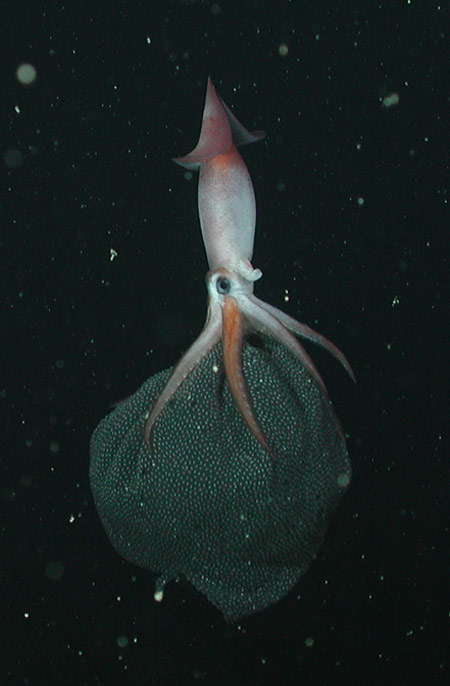The Heavy Burden of a Mother Squid

Pregnant human mothers think they have it tough, but new photos show some squid moms carry 3,000 developing embryos around for up to nine months.
Gonatus onyx is one of the most abundant species of squid in the Pacific and Atlantic Oceans and is an important food source for many predators. They spend most of their lives in shallow waters but dive to great depths to lay eggs.
Because of this, scientists had never observed this squid's reproductive habits until recently, when they discovered that the secretive world of G. onyx reproduction is quite unlike anything they've seen before.
"It's a shallow-living squid for most of its life, but then it dives down to 2,500 meters, lays 2,000 to 3,000 eggs, and carries them around for months," study leader Brad Seibel of the University of Rhode Island told LiveScience. "This is the first species of squid observed to do this."
Quite a burden
The mothers are about eight inches long from the top of their body to the end of their arms, and the addition of the egg mass extends their total length 50 to 75 percent.
As you might imagine, carrying around a load this big can be quite a burden on the squid. Normally squid propel themselves through the ocean by extending their arms outwards and snapping them back together.
Sign up for the Live Science daily newsletter now
Get the world’s most fascinating discoveries delivered straight to your inbox.
But, this technique doesn't work so well when you're delicately clutching 3,000 developing embryos between your arms. Although Seibel and his colleagues observed the squid repeatedly flushing water through the egg mass—probably to aerate the eggs in the middle—aggressive swimming shook the mass and caused some of the eggs to fall off.
To prevent losing eggs, the squid use their mantle and fins to move through the water. However, it appears that as the eggs develop, the mothers experience gradual degeneration of these locomotive muscles. A squid carrying undeveloped eggs was able to escape by vigorous fin and mantle contractions, but one with advanced eggs could not move away.
Why?
Other species of squid lay many more thousands of eggs in shallow waters without providing months of care, so why does G. onyx take the trouble to move to deeper waters—between 1,500 and 2,500 meters—and carry around the eggs for so long?
"Deep-sea species have fewer eggs, but their offspring are larger and more capable of capturing prey," Seibel said. "But in order for the offspring to survive, the parent must provide care for them for six to nine months."
Also, deeper water is relatively free of predators—predatory mammals don't frequent depths below 1,500 meters—making survival easier for both the 1/10th-inch hatchlings and their brooding mothers.
This research is detailed in the Dec. 15 issue of the journal Nature.
- Elusive Giant Squid Finally Photographed
- Mystery Ocean Glow Confirmed in Satellite Photos
- Deadly New Sea Creature Lures Fish with Red Lights
- Giant Balls of 'Snot' Explain Ocean Mystery
- A Squid that Glows










